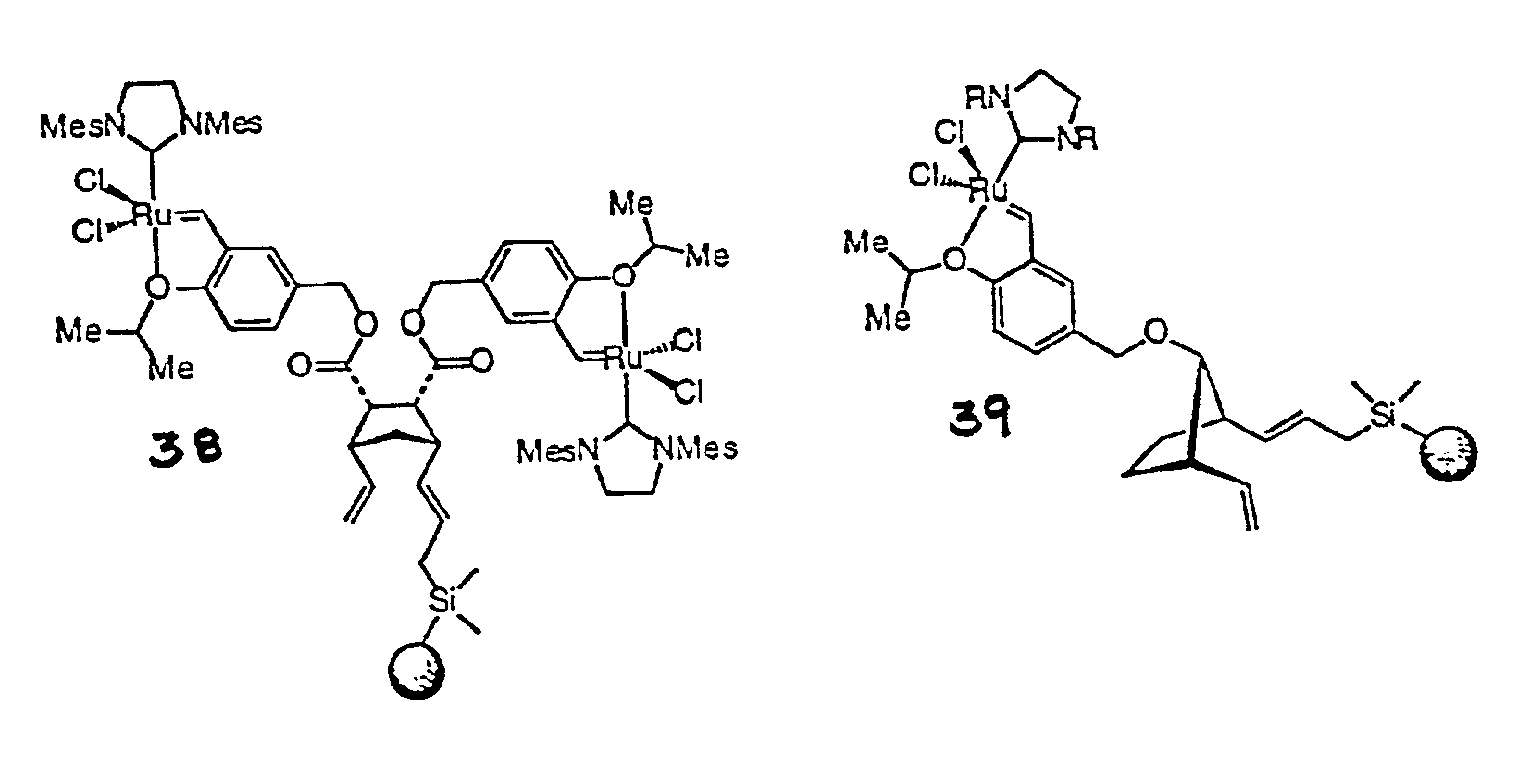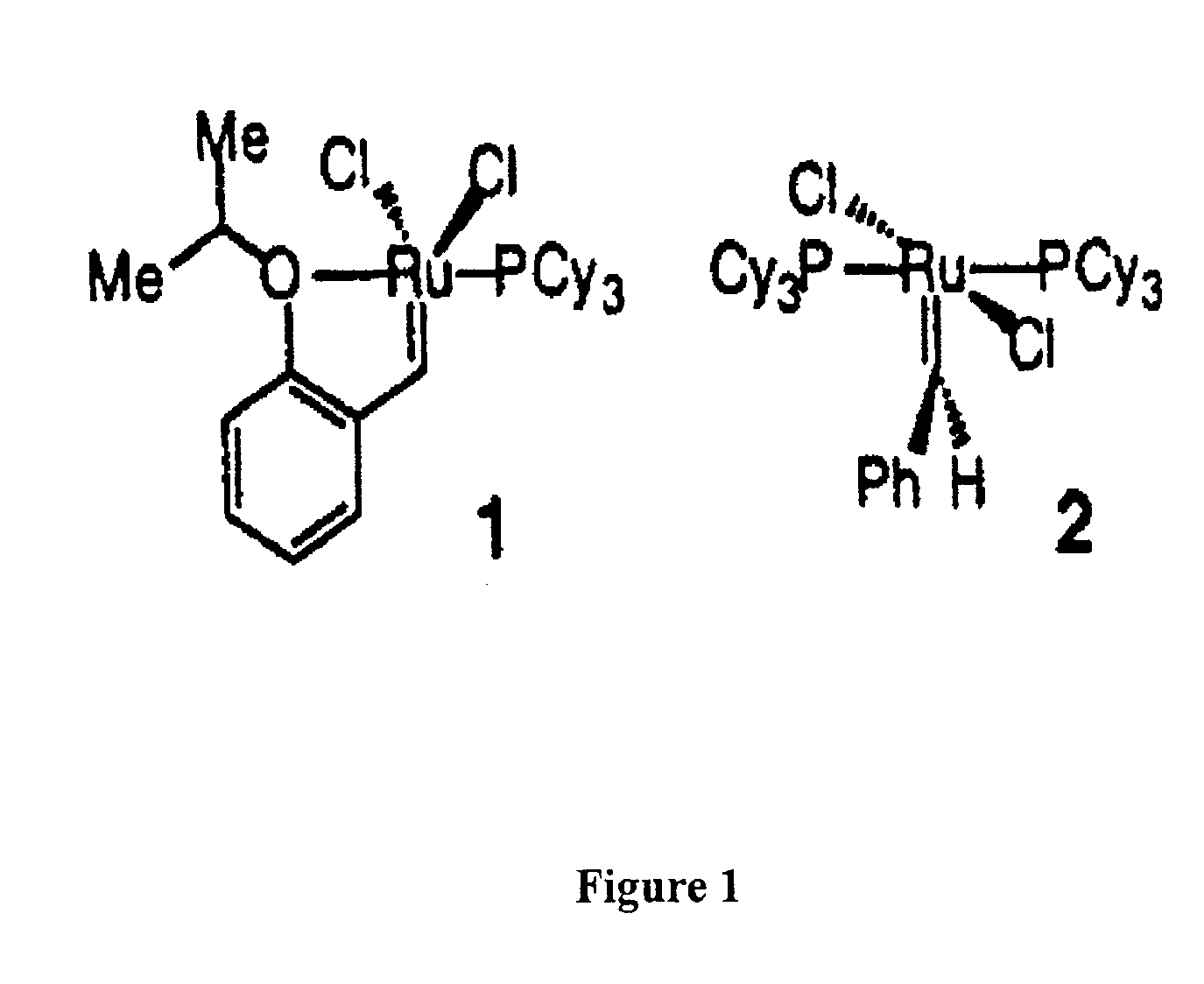Recyclable metathesis catalysts
- Summary
- Abstract
- Description
- Claims
- Application Information
AI Technical Summary
Benefits of technology
Problems solved by technology
Method used
Image
Examples
example 1
Synthesis of ((2,4,6-Trimethylphenyl)NCH)2
[0081]Glyoxal (3.73 mL of a 40% weight solution in water, 32.5 mmol) was dissolved in 325 mL of reagent-grade methanol in a 500 mL flask. 2,4,6-Trimethylaniline (8.25 mL, 58.8 mmol, 1.81 equiv) was added dropwise to this solution by syringe. The mixture was stirred for 12 h at 22° C. as a bright yellow precipitate slowly formed. The mixture was diluted with CH2Cl2, dissolving the solid. The resulting yellow solution was dried over MgSO4, filtered, and concentrated to a yellow-orange solid residue. The unpurified product was recrystallized from anhydrous methanol (for every 10 g, 850-900 mL of MeOH was required for complete dissolution at reflux). After slow cooling to 22 EC followed by subsequent storage of the sample at −20° C. for 12 h, long canary yellow crystals formed. The product was recovered by vacuum filtration, washed with pentane, and dried under high vacuum (7.40 g, 25.3 mmol, 86%). IR (NaCl): 3005 (m), 2946 (s), 2916 (s), 2854 ...
example 2
Synthesis of ((2,4,6-Trimethylphenyl)NHCH2)2.
[0082]The bis(imine) ((2,4,6-trimethylphenyl)NCH) (7.30 g, 25.0 mmol) was suspended in 250 mL of MeOH in a 500 mL round-bottom flask. Several crystals of bromocresol green were added as a pH indicator and the mixture was cooled to 0° C. NaCNBH3 (10.0 g, 159 mniol, 6.4 equiv) was added to the reaction mixture in one portion as a solid. Vigorous bubbling was observed and the reaction mixture turned a deep blue-green color (alkaline pH). After 10 mm concentrated HCl was added dropwise to the mixture, restoring its original yellow color. Additional reduction slowly occurred, causing the mixture to again become basic. The acidification process was repeated (typically two more times) until the yellow color persisted. The reaction mixture was warmed to 22° C. and stirred for 1 h. A solution of 2 M KOH was added dropwise until the mixture was weakly alkaline (pH=8-9). The mixture was then diluted with water (300 mL), transferred to a separatory ...
example 3
Synthesis of 1,3-Dimesitylimidazolinium tetrafluoroborate
[0083]A 25 mL round-bottom flask was charged with ((2,4,6-trimethylphenyl)NHCH2)2 (7.81 g, 26.4 mmol) and ammonium tetrafluoroborate (2.77 g, 26.4 mmol, 1.0 equiv). Triethylorthoformate (4.39 mL, 26.4 mmol, 1.0 equiv) was added by syringe. The flask was equipped with a reflux condenser and submerged into a preheated oil bath at 120° C. The mixture was refluxed for 3 h and cooled to 22° C. A tan-colored solid precipitated, leaving a cloudy suspension. This mixture was recrystallized from hot anhydrous ethanol. The resulting bright white crystals of product were recovered by vacuum filtration, washed with pentane, and dried under high vacuum (5.62 g, 14.3 mmol, 54%). Additional product could be obtained by further recrystallization of the mother liquor. IR (NaCl): 3091 (w), 2979 (br), 2941 (br), 1633 (s), 1487 (w), 1459 (w), 1393 (w), 1313 (w), 1269 (m), 1214 (w), 1092 (m), 1054 (s), 1036 (s), 965 (w), 880 (w), 852 (m). 1H NMR (...
PUM
| Property | Measurement | Unit |
|---|---|---|
| Fraction | aaaaa | aaaaa |
| Fraction | aaaaa | aaaaa |
| Fraction | aaaaa | aaaaa |
Abstract
Description
Claims
Application Information
 Login to View More
Login to View More - R&D
- Intellectual Property
- Life Sciences
- Materials
- Tech Scout
- Unparalleled Data Quality
- Higher Quality Content
- 60% Fewer Hallucinations
Browse by: Latest US Patents, China's latest patents, Technical Efficacy Thesaurus, Application Domain, Technology Topic, Popular Technical Reports.
© 2025 PatSnap. All rights reserved.Legal|Privacy policy|Modern Slavery Act Transparency Statement|Sitemap|About US| Contact US: help@patsnap.com



